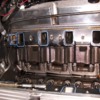As some of you may remember, this motor is that brandnew 535 hp 427 stroker that I had some vibrations issues with earlier in the year when we fired it up first time. The core to those problems turned out to be misinformation in the buildsheets from the engine builder side, leading me to believe it was externally balanced while it actually was internally balanced. After pulling the bottom end apart and checking crank, rods and pistons we realized that the engine had different components to what was listed in the build sheets - not bad components, actually better, but different components!!.
So this had me worried and I was considering taking it all apart for a thoughrow checkout, but we had the Le mans trip coming up a few weeks later and, since the car had just come out of a 4 year restoration, I had a million other bugs to work out before the trip. So we put the motor back in with the correct flywheel and it actually ran really well.
So without really having had time to test the car on longer trips we headed off for france in early july. It soon turned out that I had this oil burning problem - most noticible when at highway speeds around 3500+ rpm and especially when lifting slightly the throttle. We suspected it might be an intake gasket (most likely), a valve seal or a bad oilring but without fresh gaskets on hand, we couldn't do anything about it, except cleaning the sparkplug of cyl no 2 every 200 miles or so - and adding a quart of oil
Yesterday I pulled the intake manifold


